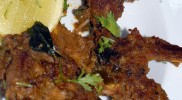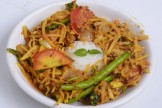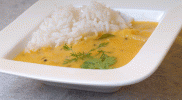

Mutton Pepper Chops is a delicious Indian recipe served as a Curries. This easy ready to ...
Easy Chicken Curry with Onion Tomato Gravy is a way for the Indian food made convenient....

Baby corn mint curry is a delicious Indian recipe. It is an aromatic combination of flav...

Green Papaya Sour Curry, Making:Take a pan and add peanuts, sesame seeds and roast it.Now...

A simple yet delicious kadi made with pineapple pieces cooked in coconut milk and spices....
This easy recipe uses previously prepared Indo Chinese Szechuan sauce that can be made ah...
This is a special and variety gulab jamun made with vegetables.
Gulab jamun is actually a traditional Asian sweet which is most popular in India, Nepal, Bangladesh, Pakistan and Sri Lanka. It's there at each and every marriage, celebration, birthday and festivals. In brief when you organize any Indian celebration and decide to keep only one sweet, the chances are it's going to be gulab jamun! This lip smacking Gulab Jamun can't replace by any other Indian desserts.
Gulab jamun are de... Read More..
|
About Recipe
|
|||||||||||||||||||||||||||||||||||||||||||||||||||||||||||
|
|||||||||||||||||||||||||||||||||||||||||||||||||||||||||||
Gulab jamun is actually a traditional Asian sweet which is most popular in India, Nepal, Bangladesh, Pakistan and Sri Lanka. It's there at each and every marriage, celebration, birthday and festivals. In brief when you organize any Indian celebration and decide to keep only one sweet, the chances are it's going to be gulab jamun! This lip smacking Gulab Jamun can't replace by any other Indian desserts.
Gulab jamun are deep-fried dumpling made from khoya or mava (a thickened blend obtained after boiling milk.) which are dipped in rose flavored sugar syrup generally flavored with cardamom and saffron. Also, the uniformity of gulab jamuns made from Khoya is very smooth that they can literally dissolve in the mouth. It may also be made using milk powder, usually though khoya can be used to produce this lip smacking sweet.
Gulab Jamun are soft, spongy and delectably sweet and so I can bet that I don't know anyone who does not like Gulab Jamuns. Jamun is known as Roseberry in India, because the shape of this sweet is around and rose water is used so it can have a fresh essence, it's famously known as Gulab Jamun.
The name Gulab Jamun arises from the Urdu/Persian language where gulab is actually a rose and jamun is a plum like fruit indigenous to South Asia. When these donuts are deep-fried they look like small dark plums and because they are soaked in the rose aromatic syrup, therefore, the Gulab Jamun.
Nowadays, Gulab Jamuns can be found in cans and also in other ready-made variations.
Types:
There are several varieties of gulab jamun and each variety contains a unique flavor and look.
Gulab jamun will get its brownish by deep frying the khoya or mava, which are dipped in rose flavored sugar syrup.
In other kinds of gulab jamun, sugar is put in the batter, and after frying, the sugar caramelize, provides it with its darkish, almost black color, which happens to be then known as kala jamun or "black jamun". The sugar syrup may be substituted with (a little) diluted maple syrup to get a gulab jamun with a Canadian taste.
Nutrients in Gulab Jamun:
One gulab jamun ball is the size of a ping-pong ball. Based upon recipe different versions, calories and nutrition specifics will vary, but each ball usually has about 140 calories. a single ball has 135 calories, 7-8 grams’ fat, 8-10 mg cholesterol, 38 mg sodium, 15 grams’ carbohydrates, no fiber and 2 g protein. Because the balls are made using milk, fortunately they are full of calcium; an individual sweet ball has in close proximity to 10 % of the suggested daily value.
 Easy recipes
Easy recipes
 Healthy Recipes
Healthy Recipes
 Dessert Recipes
Dessert Recipes
 Mutton and Lamb
Mutton and Lamb  Indian Bread Recipes
Indian Bread Recipes
 Dal Recipes
Dal Recipes
 Chutney and Pickles
Chutney and Pickles  Indo-Chinese Recipes
Indo-Chinese Recipes
 Snacks and Appetizers
Snacks and Appetizers
 Low Fat Recipes
Low Fat Recipes
 Chaat Recipes
Chaat Recipes
 Biryani and Rice
Biryani and Rice  Curry Recipes
Curry Recipes
 Indian Sweet Recipes
Indian Sweet Recipes
 Egg Recipes
Egg Recipes
 Paneer Recipes
Paneer Recipes
 Chicken Recipes
Chicken Recipes
 Indian tiffins
Indian tiffins
 Egg less Recipes
Egg less Recipes
 Soups and Salads
Soups and Salads
 Indian Sea Food
Indian Sea Food
 Manchurian Recipes
Manchurian Recipes
 Indian Drinks Recipes
Indian Drinks Recipes
 Dinner Recipes
Dinner Recipes